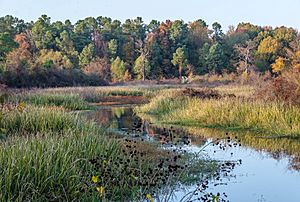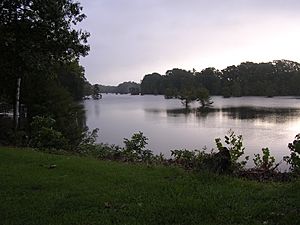Bayou Bartholomew facts for kids

The Bayou Bartholomew is an amazing natural waterway. It is the longest bayou in the world! This long stream winds for about 364 miles (586 km) through the states of Arkansas and Louisiana in the United States.
Bayou Bartholomew is home to over 100 different kinds of water animals. This makes it the second most diverse stream in all of North America. People love to fish here for bream, catfish, and crappie. Many anglers in Arkansas consider parts of the bayou to be their secret fishing spots!
The bayou starts near Pine Bluff, Arkansas. It then flows through many counties in Arkansas, like Jefferson and Ashley. After that, it enters Louisiana, flowing through Morehouse Parish. Finally, it empties into the Ouachita River near Sterlington, Louisiana. This bayou also acts as a natural border between the Arkansas Delta and the Arkansas Timberlands.
How the Bayou Formed
The bed of Bayou Bartholomew was created a long time ago. It was formed by the waters of the Arkansas River. The Arkansas River used to change its path often.
About 1,800 to 2,200 years ago, the Arkansas River moved away from this area. The old river bed then slowly became the calm bayou we see today. For a long time, before railroads were built in the late 1800s, the bayou was very important. It was the main way to transport goods in the Delta region. This helped the timber and farming industries grow in the area.
Protecting the Bayou
Bayou Bartholomew was once a very clean stream. However, some parts of it are now polluted. There are also many log jams and too much sediment (dirt and sand) in certain areas.
In 1995, a person named Dr. Curtis Merrell started a group called the Bayou Bartholomew Alliance. Their goal is to "restore and preserve the natural beauty" of the bayou. Many groups are helping them. These include the Arkansas Game and Fish Commission and the Environmental Protection Agency.
They are working on several projects. These projects include checking water quality and planting trees along the banks. They are also cleaning up trash and removing log jams. Other efforts include making the banks stronger and building boat ramps. They also encourage farmers to use "no-till farming" to help protect the soil. With these efforts, the bayou can become beautiful and healthy again.
At Beekman, LA, the bayou's average water flow is 1,985 cubic feet per second.
Location Details
- Mouth: The bayou joins the Ouachita River in Morehouse Parish, Louisiana. 32°43′22″N 92°03′50″W / 32.72291°N 92.06402°W
- Source: The bayou begins in Jefferson County, Arkansas. 34°17′01″N 92°10′11″W / 34.28355°N 92.16980°W


